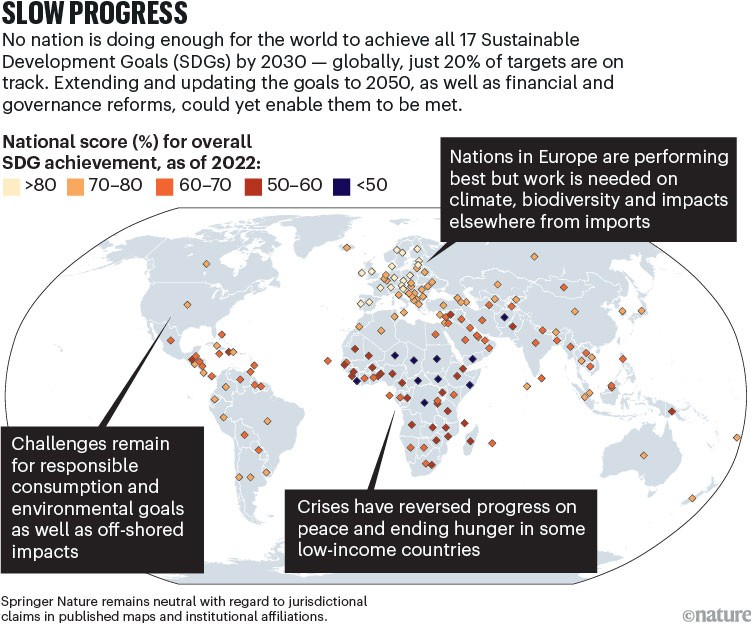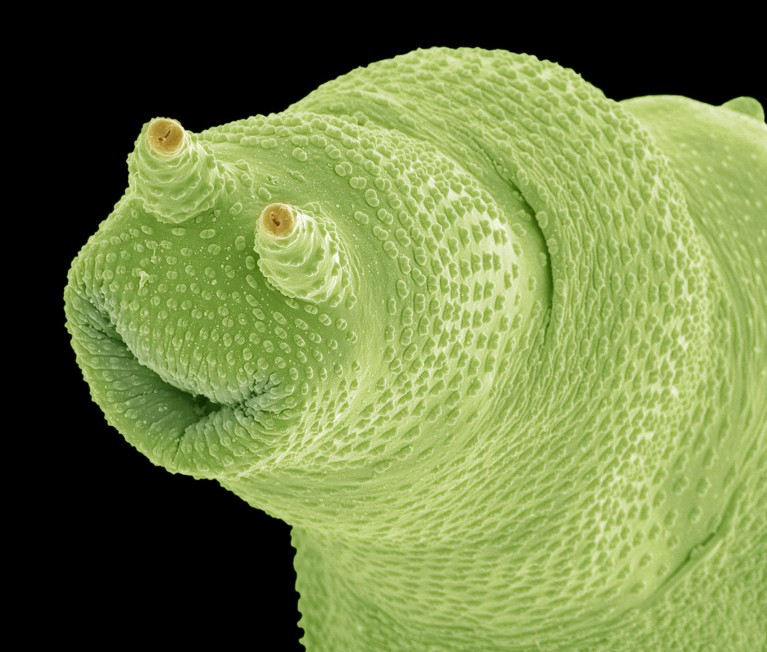Hello Nature readers, would you like to get this Briefing in your inbox free every day? Sign up here.

A water spray helps people in Bratislava to cool down on a hot summer day.Credit: Bilge Kagan Kaya/Alamy
Global warming is costing lives, deepening health inequality and driving the spread of diseases across Europe. A review of hundreds of studies has revealed that between 2013 and 2022, there were around 17 more heat-related deaths per 100,000 people per year than during the previous nine years. Warmer temperatures also mean that disease-carrying parasites including ticks and sandflies are spreading into more northern latitudes. “We really need some drastic action to be taken by European countries to help keep the European population, and also populations across the globe, safe from the health impacts of climate change,” says health researcher and study co-author Rachel Lowe.
Reference: Lancet Public Health review
Genes from century-old wheat varieties could make the high-yielding but finicky modern crop more resistant to diseases or decrease its fertilizer needs. DNA sequencing of more than 800 wheat varieties held in a seed collection from the 1920s and 30s revealed that they contained twice as much genetic diversity as around 200 modern cultivars. “I could see that we were exploring a gold mine,” says geneticist and study co-author Shifeng Cheng. By planting the antique crops, the researchers could even pinpoint some of the genes responsible for traits such as nutritional content and stress tolerance.
H5N1 avian influenza has killed millions of domestic and wild birds, as well as affecting many other animal species and spreading through US cattle. But few people are known to have been infected — only 15 worldwide, so far — and only one death, in 2022. And even among animals, some species seem to fare worse than others. There is still much to be done to understand how the virus affects different species, why people have so far been mostly spared and how that might change if the virus mutates. “There’s a lot we don’t understand,” says physician Tom Frieden, the former head of the US Centers for Disease Control and Prevention, who now heads an epidemic-prevention not-for-profit called Resolve to Save Lives. “I think we have to get over the ‘hope for the best and bury our head in the sand’ approach. Because it could be really bad.”
Features & opinion
Misinformation is undoubtedly being wielded in the swathe of elections occurring this year across the world. But it’s not clear what impact these falsehoods have. A body of research suggests that it is extremely difficult to persuade people to change their vote. But misinformation does not have to change minds to have an impact: it can mislead people about when and where to vote, or whether they should bother to vote at all. And just knowing that misinformation is out there — and believing it is influential — is enough to corrode trust in democracy, science and other structures.
Structured thinking about professional goals is common in industry and could also be effective for academics, says data scientist Tomasz Głowacki. Here are his steps for crafting an actionable development plan:
1. Ask your manager or mentor for input about your career aspirations. Be open about your strengths and weaknesses. Consider asking colleagues and students for (anonymous) feedback.
2. Have a clear idea of the end goal. Ask others about their career paths.
3. Identify the skills that you are missing and how to develop them, for example through training or working on specific projects.
The United Nations’ Sustainable Development Goals (SDGs) offer a path to a better world — but none of the 17 goals, which include combating climate change and reducing inequality, is expected to be achieved by the UN’s 2030 deadline. The world should redouble its efforts, not abandon them, argues a group of researchers from institutions in Europe and the United States. They propose that the SDGs should all remain the same, and call for greater ambition: the goal to end poverty should include providing social protection for vulnerable people, for example.
Their advice is well timed, says a Nature editorial. Talks on a post-2030 future for the SDGs have not yet officially begun, but because adjustments to them cannot be made quickly, the earlier that discussions can begin, the better. And it’s perfect timing for the SDGs to be part of the discussion at an upcoming summit of world leaders convened by UN secretary-general António Guterres to draft a ‘Pact for the Future’.
Nature comment | 13 min read & Nature editorial | 6 min read

Source: Ref. 1
Image of the week

The retracting foot of a bdelloid rotifer, a freshwater microscopic animal.Credit: Steve Gschmeissner/Science Photo Library
Scientific photographer Steve Gschmeissner images tiny creatures, cells and viruses to show the public the world he sees through the microscope. “People say to me, ‘You’re looking at horrible things — cancer cells, viruses, bacteria — but you make them look attractive and beautiful. Is that a contradiction?’,” says Gschmeissner. “It sounds odd, but a cancer cell can produce a beautiful image. People who have cancer have said to me, ‘Seeing the image helps me relate to my cancer.’ Or, ‘I know what I’m up against.’” (Nature | 5 min read)
Today I’m re-reading Breaking Through, the memoir of Nobel-prizewinning biochemist Katalin Karikó, which has just won recognition as a bestseller in Hungary. It begins with the beguiling tale of Karikó’s childhood in an earth-brick house without running water, and segues into an against-all-odds story of scientific triumph as a pioneer of mRNA technology. It was on our list of best science books back in January (Nature paywall, sorry) and is well worth a read.
Yesterday I told you about an ambitious plan to slow the spread of avian influenza among native Hawaiian birds using mosquitoes infected with a strain of Wolbachia, a naturally occurring bacterium that disrupts mozzie reproduction. I wrote that conservationists were using Aedes aegypti mozzies, but the project actually uses southern house mosquitoes, Culex quinquefasciatus. Sorry for that mistake!
Thanks for reading,
Flora Graham, senior editor, Nature Briefing
With contributions by Katrina Krämer
Want more? Sign up to our other free Nature Briefing newsletters:
• Nature Briefing: Microbiology — the most abundant living entities on our planet — microorganisms — and the role they play in health, the environment and food systems.
• Nature Briefing: Anthropocene — climate change, biodiversity, sustainability and geoengineering
• Nature Briefing: AI & Robotics — 100% written by humans, of course
• Nature Briefing: Cancer — a weekly newsletter written with cancer researchers in mind
• Nature Briefing: Translational Research — covers biotechnology, drug discovery and pharma

